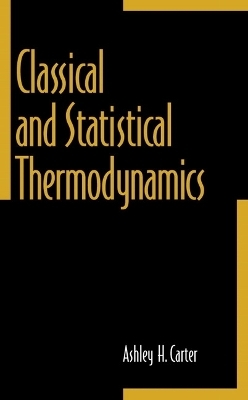
Classical and Statistical Thermodynamics
Pearson (Verlag)
978-0-13-779208-5 (ISBN)
This book provides a solid introduction to the classical and statistical theories of thermodynamics.
(NOTE: Each chapter concludes with Problems.)
1. The Nature of Thermodynamics.
What Is Thermodynamics? Definitions. The Kilomile. Limits of the Continuum. More Definitions. Units. Temperature and the Zeroth Law of Thermodynamics. Temperature Scales.
2. Equations of State.
Introduction. Equation of State of an Ideal Gas. Van der Waals' Equation for a Real Gas. P-v-T Surfaces for Real Substances. Expansivity and Compressibility. An Application.
3. The First Law of Thermodynamics.
Configuration Work. Dissipative Work. Adiabatic Work and Internal Energy. Heat. Units of Heat. The Mechanical Equivalent of Heat. Summary of the First Law. Some Calculations of Work.
4. Applications of the First Law.
Heat Capacity. Mayer's Equation. Enthalpy and hats of Transformation. Relationships Involving Enthalpy. Comparison of u and h. Work Done in an Adiabatic Process.
5. Consequences of the First Law.
The Gay-Lussac-Joule Experiment. The Joule-Thomson Experiment. Heat Engines and the Carnot Cycle.
6. The Second Law of Thermodynamics.
Introduction. The Mathematical Concept of Entropy. Irreversible Processes. Carnot's Theorem. The Clausius Inequality and the Second Law. Entropy and Available Energy. Absolute Temperature. Combined First and Second Laws.
7. Applications of the Second Law.
Entropy Changes in Reversible Processes. Temperature-Entropy Diagrams. Entropy Change of the Surroundings for a Reversible Process. Entropy Change for an Ideal Gas. The Tds Equations. Entropy Change in Irreversible Processes. Free Expansion of an Ideal Gas. Entropy Change for a Liquid or Solid.
8. Thermodynamic Potentials.
Introduction. The Legendre Transformation. Definition of the Thermodynamic Potentials. The Maxwell Relations. The Helmholtz Function. The Gibbs Function. Application of the Gibbs Function to Phase Transitions. An Application of the Maxwell Relations. Conditions of Stable Equilibrium.
9. The Chemical Potential and Open Systems.
The Chemical Potential. Phase Equilibrium. The Gibbs Phase Rule. Chemical Recessions. Mixing Processes.
10. The Third Law of Thermodynamics.
Statements of the Third Law. Methods of Cooling. Equivalence of the Statements. Consequences of the Third Law.
11. The Kinetic Theory of Gases.
Basic Assumptions. Molecular Flux. Gas Pressure and the Ideal Gas Law. Equipartition of Energy. Specific Heat Capacity of an Ideal Gas. Distribution of Molecular Speeds. Mean Free Path and Collision Frequency. Effusion. Transport Processes.
12. Statistical Thermodynamics.
Introduction. Coin-Tossing Experiment. Assembly of Distinguishable Particles. Thermodynamic Probability and Entropy. Quantum States and Energy Levels. Density of Quantum States.
13. Classical and Quantum Statistics.
Bloltzmann Statistics. The Method of Lagrange Multipliers. The Boltzmann Distribution. The Fermi-Dirac Distribution. The Bose-Einstein Distribution. Dilute Gases and the Maxwell-Boltzmann Distribution. The Connection between Classical and Statistical Thermodynamics. Comparison of the Distributions. Alternative Statistical Models.
14. The Classical Statistical Treatment of an Ideal Gas.
Thermodynamic Properties from the Partition Function. Partition Function for a Gas. Properties of a Monatomic Ideal Gas. Applicability of the Maxwell-Boltzmann Distribution. Distribution of Molecular Speeds. Equipartition of Energy. Entropy Change of Mixing Revisited. Maxwell's Demon.
15. The Heat Capacity of a Diatomic Gas.
Introduction. The Quantified Linear Oscillator. Vibrational Modes of Diatomic Molecules. Rotational Modes of Diatomic Molecules. Electronic Excitation. The Total Heat Capacity.
16. The Heat Capacity of a Solid.
Introduction. Einstein's Theory of the Heat Capacity of a Solid. Debye's Theory of the Heat Capacity of a Solid.
17. The Thermodynamics of Magnetism.
Introduction. Paramagnetism. Properties of a Spin-1/2 Paramagnet. Adiabatic Demagnetization. NegativeTemperature. Ferromagnetism.
18. Bose-Einstein Gases.
Blackbody Radiation. Properties of a Photon Gas. Bose-Einstein Condensation. Properties of a Boson Gas. Application to Liquid Helium.
19. Fermi-Dirac Gases.
The Fermi Energy. The Calculation of ...m(T). Free Electrons in a Metal. Properties of a Fermion Gas. Application to White Dwarf Stars.
20. Information Theory.
Introduction. Uncertainty and Information. Unit of Information. Maximum Entropy. The Connection to Statistical Thermodynamics. Information Theory and the Laws of Thermodynamics. Maxwell's Demon Exorcised.
Appendix A. Review of Partial Differentiation.
Partial Derivatives. Exact and Inexact Differentials.
Appendix B. Stirling's Approximation.
Appendix C. Alternative Approach to Finding the Boltzmann Distribution.
Appendix D. Various Integrals.
Bibliography.
Answers to Selected Problems.
Index.
| Erscheint lt. Verlag | 9.5.2000 |
|---|---|
| Sprache | englisch |
| Maße | 153 x 26 mm |
| Gewicht | 580 g |
| Themenwelt | Naturwissenschaften ► Physik / Astronomie ► Thermodynamik |
| ISBN-10 | 0-13-779208-5 / 0137792085 |
| ISBN-13 | 978-0-13-779208-5 / 9780137792085 |
| Zustand | Neuware |
| Haben Sie eine Frage zum Produkt? |
aus dem Bereich


